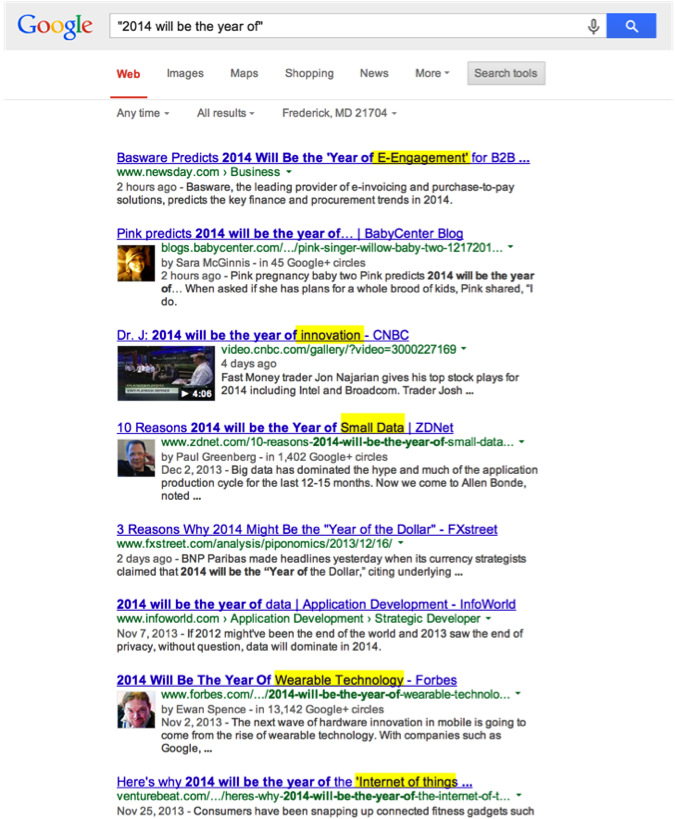by gabriel_sales | Dec 23, 2013
 This is part-two of a two part blog on B2B sales and marketing trends in 2014. Click here for part one.
This is part-two of a two part blog on B2B sales and marketing trends in 2014. Click here for part one.
Transparency
The second B2B trend I predict for 2014 is a focus on increased transparency—both internally and externally.
For the past several years, many B2B companies have started experimenting in the new world of digital content marketing, marketing automation, customer relationship management, etc. While most companies that have engaged in these strategies have seen increases in marketing effectiveness and sales revenue, executives often want to see transparent, concrete numbers before increasing budget allocation. Because of this, analytical tools for measurement of all sales and marketing tactics will become increasingly important in order to prove ROI and justify increased digital spend.
In 2014, transparency is also going to be increasingly important for prospects. One reason for this is the increased use of the Internet and web-based technologies, which have made consumers significantly more well-informed. These smarter consumers know a scam when they see one and have been bombarded with enough advertising throughout their lives to know when a company is blowing smoke. When searching for products and services, buyers today want to feel like they are having authentic experiences with truthful companies. To satisfy this desire, you need to be authentically transparent.
One example of the immense power of transparency in business is the recent success of Dominos pizza. Instead of continuing with the same marketing message they had for years, Dominos chose to listen to their customers’ feedback on the poor quality of their product. They admitted publically (through a mass media campaign) that their pizza did not meet their customers’ standards for taste and that they were completely recreating their recipe to make up for it. The result? Doubled profits.
While these will not likely be the only B2B marketing trends in 2014, I believe they are two of the most important. By incorporating co-creation and transparency into your marketing strategy and content, you can foster deeper and more authentic relationships with your prospects while simultaneously increasing the efficiency and effectiveness of everything you do.
If you have any questions about creating your sales and marketing strategy for 2014, feel free to contact us.
by gabriel_sales | Dec 23, 2013
B2B Sales Marketing Trends
In one of our blogs last week, we made the argument that regardless of whatever 2014 turns out to be the year of, content is going to be the fuel that will take us where we want to go. Whether we want to improve our social media presence or invest more in lead nurturing, content is the driving force that will lead us to either success or failure.
In addition to improving content development skills and learning to act like a publisher, B2B companies also need to be aware to two broad trends that I believe will be important in B2B sales marketing trends in 2014:
Co-creation

The first trend is co-creation. ‘Co-creation’ is a relatively big philosophical idea that has recently been applied to many business contexts and situations.
In the B2B world, the concept of ‘co-creation’ can be applied in a few ways; the first is in regards to sales and marketing integration. If your sales and marketing teams are still working separately, it is not likely that you are doing everything you can to create a smooth and easy buying process for your prospects. The current B2B sales marketing trends can be summarized as: marketing creates content that they think is cool, and sales thinks it is worthless, so it doesn’t get used.
By analyzing these marketing trends to listen to implicit and explicit feedback from your audience, they can work together to co-create content that will be more effective on both sides of the table. For example, have your marketers listen to the objections that your sales reps hear on the phone everyday. Then, have your marketers create content with your sales team that is focused on answering those objections in digital format. With everyone listening to feedback and working together toward a shared goal, efficiency and effectiveness of all of your tactics increase dramatically.
Another way the concept of co-creation can be applied to B2B is in the creation of social proof.
In B2B sales marketing trends, social proof is essentially digital evidence of your customers’ satisfaction with your company, product or service. This could be in the form of a customer testimonial, a Facebook ‘share’, a LinkedIn ‘recommendation’, etc. Each time your prospects/customers share one of your blog posts on Facebook or gives you a written testimonial to be featured on your website, they are co-creating your marketing content with you.
The power of this type of co-created content should not be underestimated. In a recent survey of B2B marketing professionals on the value of different types of content in convincing prospects of a company’s value proposition, it was found that content sourced from existing customers was not only more effective than internally sourced content, but also more effective than content from 3rd-party analysts. This shows that as we go into 2014, co-creating content with your customers (case studies, testimonials, video testimonials) is going to be an increasingly high-value activity.
To continue reading the second half of this blog, click here.
by Glen Springer | Dec 18, 2013
 It’s time to get something straight.
It’s time to get something straight.
2013 is about to wrap-up and 2014 is around the corner.
There are hundreds (if not thousands) of articles out there that profess that “2014 will be the year of …{insert technology/strategy}”.

On the first page of Google, terms include: e-engagement, innovation, small data, wearable technology, internet of things and other non-business predictions.
Even the editors at CMO.com put out a market research piece asking top marketing leaders what they believe 2014 will be the year of…and you’ll get answers across the spectrum of marketing topics: mobile, video, social, privacy, curation, relationships, branding, etc.
That’s great – 2014 will be the year of everything.
However, Gabriel Sales is of the belief that there is an underlying element that fuels all of these predictions for 2014 (and what fueled the predictions over the past decade and what will continue to be the fuel many years into the future).
Before I give away the answer, think about this…
How do you e-engage?
What do you feed a system of innovation?
What is small data?
What will people access using wearable technology?
What does the internet of things output?
Content.
Plain and simple, content is the main fuel of all of these ‘2014’ predictions and so many more.
Content is the necessary gas for marketing automation, a previously crafted analogy by Travis Arnold of Kapost, found here.
Content supports all of your marketing efforts – SEO, PPC, email marketing, nurturing, banner ads, remarketing, social and more. Without content, you are not providing any substance or value to your audience. You’re just trying to sell by being a ‘pretty face’ or the ‘smartest person in the room’. That doesn’t work anymore.
The year of 2014 isn’t just about content or content marketing, but about providing such valuable content to your audience that they can’t help wanting to buy from you because you’ve given so much value already for free.
Think of developing your content this way.
You are educating your prospects so much they feel that they have become an expert in your space. In turn, they’ll realize that if your company is providing this kind of value prior to the sale, imagine how much value your company provides to their customers.
This kind of thinking is what many call ‘viral marketing’. The content you deliver publically is so good, people want to share it to help spread that good to others. And, the service/product you deliver to your customers is so much improved that you’ll create company evangelists on both sides of the dollar sign.
For more on creating valuable and relevant content for your 2014 B2B sales/marketing efforts, read our recent blog series titled, “5 Reasons Your Content Isn’t Converting.”
This is what we do at Gabriel Sales – create and share content that supports all of your marketing and sales efforts – attracting leads, educating prospects and helping you close deals.
Feel free to contact us with any questions.
by gabriel_sales | Nov 20, 2013
 This is part-two of a blog series on five things you may be doing that hurt your B2B content marketing conversion rates. Click here for part one.
This is part-two of a blog series on five things you may be doing that hurt your B2B content marketing conversion rates. Click here for part one.
3. You aren’t offering multiple options for consumption.
In the past decade or so, the traditional mode of selling and buying was flipped on its head and now, buyers hold all the power when it comes to the game of sales. Because buyers now hold the keys in terms of when to view marketing material, how long to view and how to respond, you need to offer them as many options as possible to get them to convert.
For example, let’s say you send out an email with a link for a YouTube video attached. Now, if your prospect is on their mobile device and is taking the subway home, they may have the desire to interact with your content but don’t want to disturb the people around them by playing a loud video. By including a transcript of the video or a slide share presentation with notes attached, you can ensure that regardless of your prospects’ individual situations and preferences, you are offering relevant content they will want to engage with.
4. You aren’t telling people what you want them to do.
It is not likely that your prospects are going to convert if you don’t make it clear and easy for them to do so. Marketing content should always contain a call to action; the action itself can vary, but it should always be obvious to your viewer.
To increase conversion rates, you can use your call to action to help guide your prospect through their buying cycle by leading them from one piece of content to the next. For example, after an educational blog post, invite people to ‘learn more’ by watching your company overview video. Then, on the video page, invite prospects to ‘sign up for a custom demo’. When used in this way, calls to action are about more than just getting a prospect to click on something; they are about helping guide your prospects through their buying journey.
5. You aren’t tailoring your content for different audience segments.
Market segmentation is not a new concept anymore, so if you aren’t segmenting your content in some way at this point, you’re behind. By breaking apart your audience into different segments based on various demographic factors (title, geography, company size, department, etc.), you are able to then tailor the messaging of your content to match the different pains, needs and goals each segment may have.
Segmenting your content successfully requires in-depth knowledge of your customer base. The B2B sale now often involves multiple decision-makers and stakeholders (IT, HR, marketing, etc.), all of whom bring a different perspective to the table. By offering marketing content appropriate for each of those perspectives, you show your prospects you have taken the time to truly understand their needs and goals, which will help you earn their trust.
To learn more about B2B content marketing, you can read another educational blog post here. Please feel free to contact us with any questions.
by gabriel_sales | Nov 19, 2013
 In the past few years, many B2B companies have started blogs and YouTube channels, joined social media networks, started hosting webinars and more—having been told that putting digital content out into the world would translate to increased revenue.
In the past few years, many B2B companies have started blogs and YouTube channels, joined social media networks, started hosting webinars and more—having been told that putting digital content out into the world would translate to increased revenue.
For most companies, B2B content marketing has now become an integral part of their overall marketing program. In terms of lead generation, nurturing and relationship building, content marketing has seen tremendous success. However, we believe content marketing is successful only if it leads to an impact on sales. At the end of the day, if your content isn’t converting prospects into leads or customers, it isn’t doing its job.
In order to help you create more effective and engaging B2B marketing content, here are five things you may be doing that hurt your conversion rates:
1. You aren’t thinking about content creation strategically.
You might have the ability to produce quality content. That quality content might even be read frequently. However, if that content isn’t backed by a strategy to guide prospects from one stage of the sales cycle to the next, it won’t help you convert leads.
In order for B2B marketing content to be useful for conversion, you need to map out the stages of your buyer’s buying cycle and then develop different pieces of content to match each stage. The purpose of this is to allow you buyer to take themselves through their buying cycle on their own. This means you need basic level, purely educational blog posts to help with discovery as well as highly technical product/software demos to encourage the close—and everything in between. By thinking strategically about content creation, you ensure that every piece of content you create has a purpose and end goal in mind, leading to dramatically increased conversion.
2. You aren’t talking in specifics.
A lot of B2B content marketing gets ignored because it doesn’t really say much. Everyone can say their solution “increases ROI” or “cuts expenses”, but that doesn’t actually tell your prospects anything about how you are different than your competitors. By avoiding specifics in your marketing content, your prospects are left wondering, “OK, but how does that work exactly?” or worse, “Does this person even know what they are talking about?”
While you don’t want to be overly technical and talk over the heads of your prospects, you do want your content to convince them of your expertise. By going into specific details when appropriate (i.e. when you are explaining your value proposition), your prospects feel like they are educated enough to make an informed purchase decision.
To continue reading, click here.
by gabriel_sales | Oct 4, 2013
 As a part of an integrated content marketing strategy, producing B2B video content marketing has become a requirement for B2B companies today.
As a part of an integrated content marketing strategy, producing B2B video content marketing has become a requirement for B2B companies today.
If you think about your own personal internet use, it is likely you now spend a fair amount of time watching videos—music videos, news clips and of course, who could forget about the cats. Most of your B2B prospects are doing the same thing and have therefore become accustomed to getting their information in this format in recent years.
This means you also need to be present your message in video format to appease the new YouTube-loving buyer. If you’re yet jump on the bandwagon of B2B video content marketing or need some assistance creating more effective videos, we’ve assembled a list of relevant educational blog articles to help you get started:
Tips for Strategy & Execution
If you need help creating B2B video marketing content, getting your videos in front of ideal market or executing video content marketing campaigns, we can help. You can find out more about what we do on our services page.
Please feel free to contact us with any questions.
 This is part-two of a two part blog on B2B sales and marketing trends in 2014. Click here for part one.
This is part-two of a two part blog on B2B sales and marketing trends in 2014. Click here for part one.





